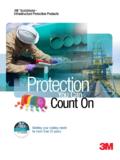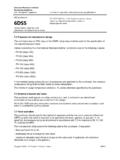Transcription of RESEARCH REPORT 320 - Health and Safety Executive
1 HSEH ealth & SafetyExecutiveElastomers for fluid containment in offshore oil and gas production: Guidelines and review Prepared by MERL Ltd for the Health and Safety Executive 2005 RESEARCH REPORT 320 HSEH ealth & SafetyExecutiveElastomers for fluid containment in offshore oil and gas production: Guidelines and review Dr R P Campion, Dr B Thomson and Dr J A Harris MERL Ltd Tamworth Road Hertford SG13 7DG A set of guidelines has been generated and an associated detailed review developed to cover technical aspects associated with the use of elastomers for fluid containment in offshore Oil & Gas production.
2 Information is provided for management systems associated with selecting appropriate material-types and designs and of acceptable operating strategies to reduce risks. The opportunity is also given to learn more about background features of elastomers and their behaviour when exposed to fluids. Elastomeric components (seals, hoses and many others) are employed extensively for such fluid containment, often in critical locations. Many applications are long-established, with elastomeric components able to function for many years in fluid containment, up to 20 years or more.
3 However, some deterioration is always taking place. The ever-present point of issue is whether deterioration will lead to failure before the design life is achieved. In some cases, deterioration can follow predictable routes with chemical ageing, timedependent properties such as creep or stress relaxation, or fluid-related kinetic factors such as permeation or diffusion. Hence, estimations can be made as to whether or not an elastomeric component so-exposed can function to completion of design life. Other forms of deterioration sometimes seen at high service pressures, such as explosive (rapid gas) decompression or seal-housing extrusion damage, are less predictable; here, prior testing of materials under realistic laboratory simulations of operating conditions is necessary to demonstrate the material s resistance to such failure-modes.
4 This REPORT and the work it describes were funded by the Health and Safety Executive (HSE). Its contents, including any opinions and/or conclusions expressed, are those of the authors alone and do not necessarily reflect HSE policy. HSE BOOKS Crown copyright 2005 First published 2005 ISBN 0 7176 2969 4 All rights reserved. No part of this publication may be reproduced, stored in a retrieval system, or transmitted in any form or by any means (electronic, mechanical, photocopying, recording or otherwise) without the prior written permission of the copyright owner.
5 Applications for reproduction should be made in writing to: Licensing Division, Her Majesty's Stationery Office, St Clements House, 2-16 Colegate, Norwich NR3 1BQ or by e-mail to ii ACKNOWLEDGEMENTS The HSE and the MERL authors wish to thank those listed below and their employers for invaluable comments which have helped focus this document on its objectives for the upstream O & G industry. Stephen Groves David Orr Steven Paterson, Frans Janssen John Boran, Alan Gibson Dave Shaw Phil Embury Tom Farley Bob Jeavons Chris Stowell John Davis BP Baker Oil Tools Shell Nexen Petroleum UK Ltd CB&I/John Brown James Walker Parker Seal Gulf Coast Seals Trelleborg Dunlop Oil & Marine iii FOREWORD The HSE require offshore Oil & Gas engineering areas to be managed safely.
6 As part of this, their objectives for this document are: (i) Generation of a set of guidelines for the use of elastomers in fluid containment offshore. These should provide information for management systems associated with the selection of appropriate designs and acceptable operating strategies. (ii) Development of a review document relating to the use of elastomers on offshore installations, to be in sufficient detail to lead to the generation of the guidelines, and to act as technical background where required when implementing the guidelines.
7 This document therefore consists of two parts: Part 1 covering the guidelines and Part 2 the review. The work focuses on elastomer-based components in general upstream oil and gas (O & G) production usage for the UK continental shelf, with limited comments only being made on some other components used here and elsewhere. The components assessed are assumed to contain fluid being transported, either for drilling, completion, production, treatment, control or Safety reasons. Other usage of elastomers offshore are not considered herein, such as elastomer-based components ( flexelements) whose sole function is to be part of the supporting structure for all or part of an oilrig etc, or elastomer coating systems, or steel-lined hoses possessing external elastomeric layers.
8 Iv Executive SUMMARY To ensure the safe use of elastomeric materials offshore, their behavioural characteristics and an awareness of how and where risks might be associated with their usage should be well understood. It should then be possible to identify where suitable risk control measures should be applied for elastomeric components. Elastomers constitute the most flexible, deformable and elastic of the three classes of the non metallic materials polymers . As such, elastomers are employed extensively throughout the industry for fluid containment in offshore oil & gas production, often in critical locations.
9 Important applications use elastomeric components as seals (including packers, plugs, repair clamps), hoses/bonded flexible pipes, flexible joints, valve sleeves, pulsation damper bladders and bellows. Many of these applications are long-established; correctly-specified elastomers can function for many years in fluid containment, up to 20 years or more. Despite this, the nature of elastomers is such that, when used in contact with fluids and/or subjected to applied forces, significant deterioration may occur.
10 However, modes of deterioration can follow predictable routes such that an elastomeric component so-exposed can continue to function, often to completion of design life. In other instances, change-out might be necessary before design life is complete; prior knowledge of mechanisms involved and procedures to adopt as a consequence is recommended for all such cases. To develop such knowledge, functional properties, deterioration modes, and factors affecting function performance should be considered. These inform on the sequence of key stages of specification, operation and monitoring.














